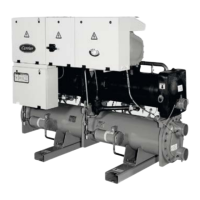42
These valves are designed to isolate the compressor from the rest
of the circuit. Discharge valves, oil valves and cooling valves are
installed in the standard unit. A label attached to the evaporator
near each valve shows the open or closed position of the valve. It
is important to remove the cap in order to manoeuvre the valve
shaft and to replace it after this operation to ensure leak-tightness.
The control boxes are leak-tight and equipped with a ventilation
system to ensure cooling of the electrical components. The control
box fan is controlled by a thermostat (setpoint 55°C, differential
20°C). A safety thermostat switches the unit off, if the control
box temperature exceeds 60°C.
These elements can be shown on the unit and on the wiring
diagram.
The control boxes are leak-tight and equipped with heaters. The
standard components are already treated for “all-weather”
operation. Heating the air will reduce the moisture level in the
control box and prevent condensation.
These units are equipped with ange connections on the refrigerant
piping to permit disassembly of the units without unwelding. The
dimensional drawing for this option gives the weight of the
different parts. The units are fully factory-assembled, charged with
oil and refrigerant and run-tested at the end of the assembly line.
The refrigerant charge is then removed and replaced by a nitrogen
holding charge.
IMPORTANT: The oil charge remains in the unit and must not
be exposed to moisture during disassembly and reassembly. The
refrigerant charge is not supplied and must be provided on site.
Please refer to the unit nameplate.
Air conditioning equipment must be maintained by professional
technicians, whilst routine checks can be carried out locally by
specialised technicians. See the standard EN 378-4.
Simple preventive maintenance will allow you to get the best
performance from your HVAC unit:
• improved cooling performance
• reduced power consumption
• prevention of accidental component failure
• prevention of major time-consuming and costly
interventions
• protection of the environment
There are ve maintenance levels for HVAC units, as dened by
the AFNOR X60-010 standard.
External visual checks. These controls must be carried out:
• After an intervention that is likely to affect the resistance or
a change in use or change of high-pressure refrigerant, or
after a shut down of more than two years. Components that
do not comply, must be changed. Test pressures above the
respective component design pressure must not be applied.
• After repair or signicant modications or signicant system
or component extension.
• After re-installation at another site.
• After repair following a refrigerant leak.
The frequency of refrigerant leak detection can vary from
once per year for systems with less than 1% leak rate per year
to once a day for systems with a leak rate of 35% per year or
more. The frequency is in proportion with the leak rate.
NOTE: High leak rates are not acceptable. The necessary steps
must be taken to eliminate any leak detected.
NOTE 2: Fixed refrigerant detectors are not leak detectors, as
they cannot locate the leak.
Component, piping and connection soldering and welding
operations must be carried out using the correct procedures and by
qualied operators. Pressurised containers must not be subjected
to shocks, nor to large temperature variations during maintenance
and repair operations.
IMPORTANT: These units are designed for use with R-134a only.
DO NOT USE ANY OTHER refrigerant in these units.
CAUTION: When adding or removing charge, circulate water
through the condenser (HX) and cooler at all times to prevent
freezing. Freezing damage is considered abuse and may void
the Carrier warranty.
All refrigerant removal and draining operations must be carried
out by a qualied technician and with the correct material for
the unit. Any inappropriate handling can lead to uncontrolled
uid or pressure leaks.
CAUTION: DO NOT OVERCHARGE system. Over-charging results
in higher discharge pressure with higher cooling uid consumption,
possible compressor damage and higher power consumption.

